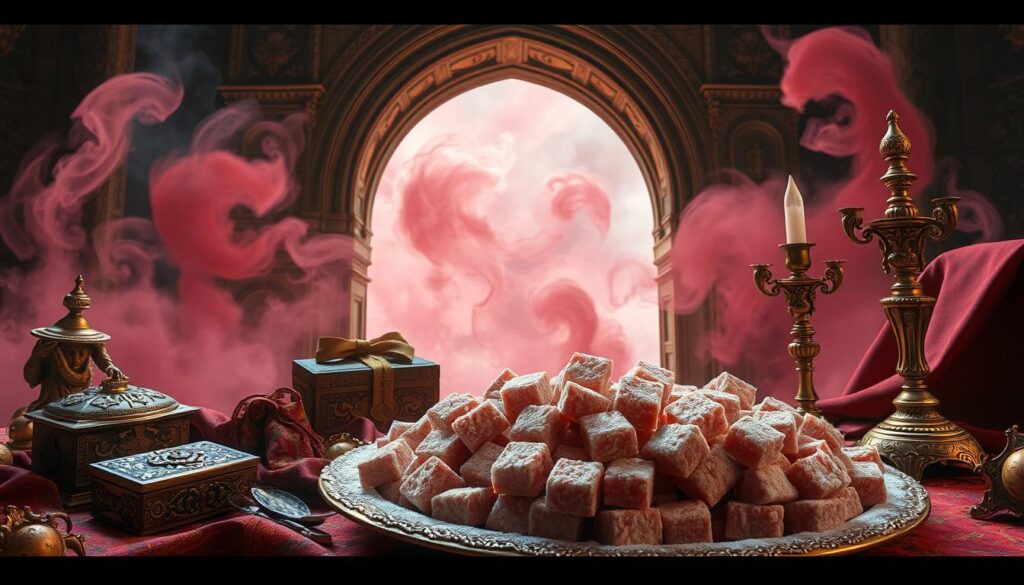We explore the enchanting world of Turkish Delight in C.S. Lewis’s “The Chronicles of Narnia: The Lion, the Witch and the Wardrobe.” This sweet treat plays a pivotal role in the narrative, serving as both a plot device and a powerful symbol that has captivated readers for generations.
In the story, the White Witch uses Turkish Delight to tempt Edmund, one of the four Pevensie children, into betraying his siblings. This iconic scene showcases the magic and allure of the confectionery, highlighting its significance in the context of food and temptation.
We’ll examine the cultural context of Turkish Delight and its representation of themes such as desire, loyalty, and the consequences of giving in to temptation in “The Lion, the Witch and the Wardrobe.”
Key Takeaways
- Understanding the role of Turkish Delight in “The Chronicles of Narnia”
- Analyzing its cultural significance in post-war Britain and Narnia
- Exploring the themes associated with Turkish Delight in the narrative
- Examining C.S. Lewis’s choice of Turkish Delight as a plot device
- Discussing the symbolism of Turkish Delight in the context of temptation and betrayal
What is Turkish Delight?
As we explore the mystique surrounding Turkish Delight, we uncover a story of tradition, cultural significance, and a unique culinary identity. Turkish Delight, also known as lokum, has been a beloved confectionery treat for centuries, captivating the hearts of many with its gelatinous texture and diverse flavors.
Origins and Traditional Ingredients
Turkish Delight originated in Turkey and is made from a gel created by heating sugar and starch, typically cornstarch. The traditional recipe involves heating a mixture of sugar syrup and a cornstarch slurry until it thickens into a gel. This gel is then flavored with ingredients like rosewater, lemon, or mint, and sometimes includes add-ins such as pistachios or walnuts. The process involves a delicate balance of heat and precise ingredients to achieve the characteristic gel-like consistency.
| Main Ingredients | Role in Recipe |
|---|---|
| Sugar | Provides sweetness and structure |
| Cornstarch | Acts as a thickening agent |
| Water | Used to create the sugar syrup and cornstarch slurry mixture |
| Flavorings (e.g., rosewater) | Adds unique flavour profiles |
Cultural Significance of the Sweet
Turkish Delight has been a symbol of hospitality and celebration throughout the Middle East for centuries. It is often served with coffee on special occasions, signifying luxury and warmth. The cultural significance of Turkish Delight extends beyond its taste; it represents a tradition of welcoming guests and celebrating special events. As noted in historical accounts, Turkish Delight made its way to Victorian and Edwardian Britain, where it was considered a rare and luxurious imported sweet. C.S. Lewis likely chose it for ‘The Chronicles of Narnia’ due to its exotic appeal, as discussed on Historical Foods.

Turkish Delight in The Chronicles of Narnia
C.S. Lewis masterfully weaves Turkish Delight into the fabric of “The Chronicles of Narnia,” using it to explore themes of temptation and betrayal through Edmund’s character. In the story, the White Witch uses Turkish Delights to tempt Edmund, one of the four Pevensie children, into tricking the rest of his siblings into returning to the mysterious world behind the Wardrobe. This pivotal scene not only showcases Lewis’s vivid storytelling but also highlights the symbolic significance of Turkish Delight in the narrative.
Edmund’s Temptation Scene
The scene where Edmund first encounters the White Witch and is offered the enchanted Turkish Delight is a critical moment in the story. Lewis’s careful description of both the confection and Edmund’s reaction to it draws the reader into the world of Narnia. We experience the overwhelming allure of the Turkish Delight through Lewis’s use of sensory details, making us understand the powerful hold it has over Edmund. As Edmund succumbs to the temptation, his willingness to betray his siblings for more of this magical candy reveals fundamental weaknesses in his character that drive the plot forward. For more insights into the historical context of Turkish Delight, visit our article on Turkish Delight in The Chronicles of.

The White Witch’s Magical Enhancement
The White Witch’s magical enhancement of the Turkish Delight transforms it from a simple sweet into an addictive substance that creates an insatiable craving, amplifying its power as a tool of manipulation. This enchantment not only affects Edmund’s actions but also serves as a metaphorical representation of temptation, making it a memorable moment that resonates with readers of all ages. As we reflect on this scene, we are left to question whether we might have made the same choice in Edmund’s position, highlighting the complexity of human nature and the power of temptation. The use of Turkish Delight in this context underscores its significance in the narrative, symbolizing both the literal and figurative allure of forbidden pleasure.
Symbolism of Turkish Delight in Narnia
The allure of Turkish Delight in Narnia is a powerful metaphor that warrants closer examination. In C.S. Lewis’s narrative, this sweet treat is not merely a delightful indulgence but a complex symbol that conveys moral lessons to readers. We will explore how Turkish Delight functions within the story as a symbol of temptation, addiction, and betrayal.
Temptation and Sin
Turkish Delight is used by the White Witch to tempt Edmund, one of the four Pevensie children, into betraying his siblings. This act draws parallels to biblical imagery of forbidden fruit, highlighting the consequences of giving in to immediate desires. The sweet taste of Turkish Delight represents the initial allure of sin, which often masks its long-term detrimental effects. As we analyze this scene, it becomes clear that Lewis uses food as a vehicle for moral instruction, making the concept of temptation tangible for young readers. The enchanted Turkish Delight serves as a metaphor for the way sin can entice individuals with promises of pleasure, only to lead them astray.
Addiction and Control
The addictive quality of the enchanted Turkish Delight represents how sin can create patterns of dependency. Edmund finds himself unable to resist the White Witch’s offer, despite knowing the potential consequences. This addictive nature of the sweet treats symbolizes the way pleasure can be weaponized as a means of control. The White Witch uses Edmund’s desire for more candy to manipulate him into betraying his family, illustrating the dangers of allowing desires to dictate actions. As we examine this dynamic, it becomes evident that Lewis is cautioning against the dangers of prioritizing immediate gratification over long-term consequences and relationships.

Betrayal for Pleasure
Edmund’s willingness to trade his siblings’ safety for more Turkish Delight represents the human tendency to prioritize immediate gratification over long-term consequences and relationships. This act of betrayal is a central theme in Lewis’s moral framework, highlighting the destructive nature of allowing desires to govern our actions. The Turkish Delight becomes a symbol of the way pleasure can lead individuals down a path of destruction, emphasizing the importance of self-control and moral integrity.
| Symbolism | Description | Consequence |
|---|---|---|
| Temptation | The White Witch uses Turkish Delight to tempt Edmund. | Edmund betrays his siblings. |
| Addiction | The enchanted sweet creates a pattern of dependency. | Edmund becomes controlled by his desire for more. |
| Betrayal | Edmund prioritizes his desire for Turkish Delight. | He compromises his family’s safety. |
C.S. Lewis’s Intentional Choice of Turkish Delight
C.S. Lewis’s choice of Turkish Delight in “The Lion, the Witch and the Wardrobe” was a deliberate narrative decision that warrants closer examination. To understand this choice, we must consider the historical context in which Lewis wrote the novel.
Post-War Rationing Context
Lewis wrote “The Lion, the Witch and the Wardrobe” in the aftermath of World War II, a time when Britain was still recovering from the effects of wartime rationing. Sugar and sweets were strictly rationed until 1953, making candy an especially powerful symbol of luxury and temptation. For British children reading the book when it was published in 1950, the idea of unlimited sweets would have been particularly enticing, enhancing the believability of Edmund’s betrayal. The scarcity of sweets during this period made the White Witch’s offer of Turkish Delight even more alluring, symbolizing a world of plenty and indulgence. As we explore in our analysis on Engelsberg Ideas, this context adds depth to Lewis’s narrative.
- The rationing of sugar and sweets until 1953 heightened the symbolic value of Turkish Delight.
- British children in the post-war era would have found the concept of unlimited sweets highly appealing.
- Lewis’s use of Turkish Delight tapped into the cultural nostalgia and longing for pre-war luxuries.
Exotic Appeal to British Readers
Lewis’s decision to use Turkish Delight rather than a more common British sweet was likely due to its exotic origins and unusual texture, which made it mysterious and special. The foreign nature of Turkish Delight would have added to its allure for British readers, representing something outside their ordinary experience—much like Narnia itself. This parallel between the exotic candy and the magical realm created a powerful narrative tool, drawing readers into the world of the story. The use of such an unusual treat helped to underscore the fantastical elements of the narrative, making the White Witch’s temptation even more compelling.
By choosing Turkish Delight, Lewis not only reflected the cultural and economic realities of his time but also enhanced the fantastical elements of his narrative, creating a rich and immersive world that continues to captivate readers today.
Conclusion: The Enduring Power of Food Symbolism
In the realm of literary symbolism, few treats have made as lasting an impact as the Turkish Delight featured in The Chronicles of Narnia. This sweet confection has become an indelible part of literary culture, symbolizing complex themes that continue to intrigue readers and viewers alike.
The enduring appeal of Turkish Delight lies in its universal symbolism. Food, as a literary device, taps into fundamental human experiences of hunger, desire, and temptation, making it a potent tool for exploring moral questions. The Chronicles of Narnia exemplifies this, using Turkish Delight to represent the allure of sin and the consequences of succumbing to temptation.
Modern adaptations of Narnia, such as the 2005 film, have further cemented the significance of the Turkish Delight scene. Contemporary audiences connect with its symbolic meaning, even if they’ve never tasted the sweet. This demonstrates the power of food symbolism in literature to transcend time and cultural boundaries.
For those interested in experiencing this legendary confection, making authentic Turkish Delight requires patience and precision, much like the moral lessons in Lewis’s story demand careful consideration. The process involves heating a mixture of ingredients, including water and gelatine, to a precise temperature, then allowing it to set before cutting it into pieces.
In conclusion, the simple yet potent Turkish Delight has evolved from a plot device to a cultural touchstone, illustrating the effectiveness of food symbolism in literature. It highlights deeper truths about human nature and moral choice, continuing to captivate audiences today in a way that remains both timeless and timely.


